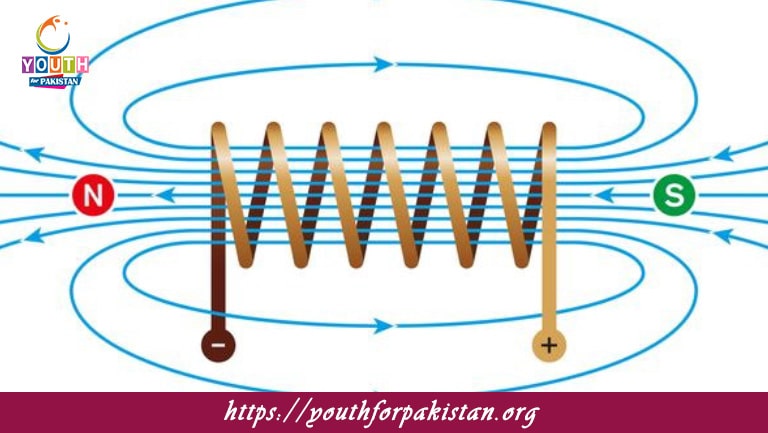Magnetic Flux MDCAT MCQs with Answers

Welcome to the Magnetic Flux MDCAT MCQs with Answers. In this post, we have shared Magnetic Flux Multiple Choice Questions and Answers for PMC MDCAT 2024. Each question in MDCAT Physics offers a chance to enhance your knowledge regarding Magnetic Flux MCQs in this MDCAT Online Test.
Magnetic Flux MDCAT MCQs Test Preparations
Magnetic flux is defined as:
a) The rate of change of magnetic field
b) The product of magnetic field and area perpendicular to it
c) The ratio of magnetic field to the area
d) The intensity of the magnetic field
The unit of magnetic flux in the International System of Units (SI) is:
a) Weber
b) Tesla
c) Ampere
d) Henry
The formula for magnetic flux is given by:
a) Φ = B × A
b) Φ = B × A × cosθ
c) Φ = B / A
d) Φ = B × A × sinθ
If the angle between the magnetic field and the normal to the surface is 90 degrees, the magnetic flux through the surface is:
a) Maximum
b) Minimum
c) Zero
d) Equal to the area of the surface
The magnetic flux through a loop of area A in a uniform magnetic field B is given by:
a) B / A
b) B × A
c) B × A × sinθ
d) B × A × cosθ
Magnetic flux can be increased by:
a) Increasing the area of the surface
b) Decreasing the strength of the magnetic field
c) Decreasing the angle between the magnetic field and the surface normal
d) Both a and c
The direction of the magnetic flux through a surface is:
a) Perpendicular to the surface
b) Parallel to the surface
c) Tangential to the surface
d) In the direction of the current
Magnetic flux through a closed loop depends on:
a) The shape of the loop
b) The strength of the magnetic field
c) The orientation of the loop with respect to the magnetic field
d) All of the above
If the magnetic field through a surface changes with time, the induced electromotive force (EMF) is:
a) Zero
b) Constant
c) Directly proportional to the rate of change of flux
d) Inversely proportional to the rate of change of flux
The phenomenon of electromagnetic induction is governed by:
a) Coulomb’s Law
b) Newton’s Laws
c) Faraday’s Law
d) Ampère’s Law
The magnetic flux through a coil of N turns is:
a) N × Φ
b) Φ / N
c) Φ × N
d) N + Φ
In a uniform magnetic field, if the area of a surface is doubled while keeping the angle the same, the magnetic flux:
a) Doubles
b) Quadruples
c) Remains the same
d) Halves
When the magnetic field is parallel to the surface, the magnetic flux is:
a) Maximum
b) Minimum
c) Zero
d) Equal to the magnetic field strength
The magnetic flux through a given surface is inversely proportional to:
a) The strength of the magnetic field
b) The angle between the magnetic field and the surface
c) The area of the surface
d) The permeability of the medium
In which situation is the magnetic flux through a surface maximized?
a) When the magnetic field is perpendicular to the surface
b) When the magnetic field is parallel to the surface
c) When the area of the surface is minimized
d) When the angle between the magnetic field and the surface is 90 degrees
The magnetic flux through a surface can be zero even if the magnetic field is non-zero if:
a) The area is zero
b) The magnetic field is uniform
c) The angle between the field and the surface is 90 degrees
d) The surface is not closed
Magnetic flux is a scalar quantity because it:
a) Depends only on the magnitude of the magnetic field
b) Is a product of vectors but results in a scalar
c) Has direction but no magnitude
d) Is independent of the area of the surface
If the magnetic flux through a surface is increasing, an induced EMF will be generated according to:
a) Lenz’s Law
b) Ampère’s Law
c) Gauss’s Law
d) Coulomb’s Law
The total magnetic flux through a closed surface is:
a) Equal to the magnetic field strength
b) Always zero
c) Proportional to the area of the surface
d) Dependent on the angle of inclination
The change in magnetic flux through a coil induces a current according to:
a) Faraday’s Law
b) Ohm’s Law
c) Kirchhoff’s Law
d) Ampère’s Law
Magnetic flux density is measured in:
a) Volts per meter
b) Amperes per meter
c) Tesla
d) Newtons per Coulomb
A magnetic flux of 1 Weber is equivalent to:
a) 1 Tesla meter²
b) 1 Tesla meter
c) 1 Tesla / meter
d) 1 Tesla / second
The magnetic flux through a surface changes if:
a) The magnetic field strength changes
b) The area of the surface changes
c) The angle between the magnetic field and the surface changes
d) All of the above
A flux of 3 Weber is associated with:
a) A magnetic field of 3 Tesla through a 1 m² area
b) A magnetic field of 1 Tesla through a 3 m² area
c) A magnetic field of 3 Tesla through a 3 m² area
d) Both a and b
The flux through a surface with a magnetic field strength of 5 Tesla and an area of 2 m² is:
a) 5 Weber
b) 10 Weber
c) 2.5 Weber
d) 7 Weber
If the magnetic field is increased while keeping the surface area constant, the flux will:
a) Decrease
b) Increase
c) Remain unchanged
d) Depend on the direction of the field
Magnetic flux is zero when:
a) The magnetic field is perpendicular to the surface
b) The magnetic field is parallel to the surface
c) The surface area is zero
d) The magnetic field strength is zero
To maximize magnetic flux through a loop, the loop should be:
a) Aligned parallel to the magnetic field
b) Aligned perpendicular to the magnetic field
c) Aligned at a 45-degree angle
d) Rotated randomly
The flux linkage in a coil is:
a) The product of the flux and the number of turns
b) The flux through each turn divided by the number of turns
c) The flux per unit length
d) The rate of change of magnetic flux
If a loop of area 0.5 m² is in a uniform magnetic field of 2 Tesla and the angle between the field and the normal to the loop is 60 degrees, the magnetic flux is:
a) 1 Weber
b) 0.5 Weber
c) 0.86 Weber
d) 0.25 Weber
When the magnetic field is perpendicular to the surface, the flux through the surface is:
a) The maximum value
b) Zero
c) Dependent on the magnetic field strength
d) Independent of the area
To reduce the magnetic flux through a surface, you can:
a) Increase the angle between the magnetic field and the surface normal
b) Decrease the strength of the magnetic field
c) Decrease the surface area
d) All of the above
The magnetic flux through a surface when the angle between the magnetic field and the surface normal is 45 degrees is:
a) Φ = B × A
b) Φ = B × A / √2
c) Φ = B × A × cos(45°)
d) Φ = B × A × sin(45°)
Magnetic flux through a surface is greatest when:
a) The surface is at an angle of 30 degrees to the field
b) The surface is perpendicular to the field
c) The surface is parallel to the field
d) The field strength is minimized
When a magnetic field is uniform and the surface area is increased, the flux through the surface:
a) Increases proportionally
b) Decreases proportionally
c) Remains the same
d) Is halved
The change in magnetic flux through a loop can cause:
a) Magnetic repulsion
b) Induced current
c) Electric potential
d) Magnetic pole formation
If the magnetic field strength is doubled while the area and angle remain constant, the flux through the surface:
a) Remains unchanged
b) Doubles
c) Quadruples
d) Halves
The concept of magnetic flux is used to understand:
a) Electric fields
b) Gravitational fields
c) Electromagnetic induction
d) Nuclear forces
If the magnetic field is variable over time, the change in magnetic flux will:
a) Always be constant
b) Cause a varying induced EMF
c) Have no effect on the induced EMF
d) Be zero
The magnetic flux through a closed loop is:
a) Always positive
b) Always negative
c) Zero in a static magnetic field
d) Equal to the product of magnetic field and loop area
If you are interested to enhance your knowledge regarding Physics, Chemistry, Computer, and Biology please click on the link of each category, you will be redirected to dedicated website for each category.





